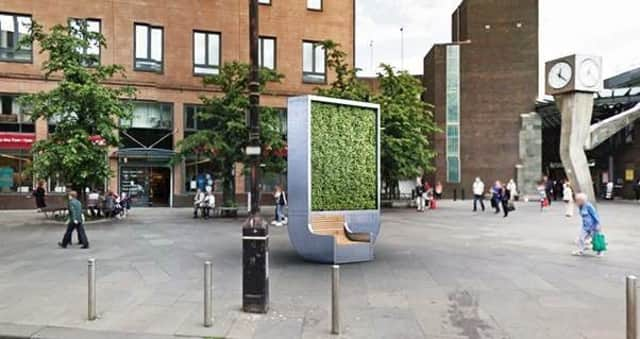Living sculptures to tackle toxic fumes in Glasgow city centre


Contaminated air is one of the world’s invisible killers, and has been identified as the biggest single environmental health risk.
Poor air quality increases the risk of stroke, heart disease, lung cancer and respiratory diseases, including asthma.
Advertisement
Hide AdAdvertisement
Hide AdIt causes 40,000 premature deaths every year in the UK – 2,500 of them in Scotland.
Glasgow has been named among the UK’s most polluted cities, breaching air pollution safety levels.
Traffic is the dominant cause and is responsible for 80 per cent of nitrogen dioxide emissions.
But now state-of-the-art green structures are being brought in to help purify the atmosphere in two of the city’s busiest streets – Royal Exchange Square, near Glasgow’s Gallery of Modern Art, and Killermont Street, by the bus station.
Known as CityTrees, they are covered in a moss-like plant that sucks potentially deadly nitrates from the air.
Inventors claim the two installations, each measuring around 4m tall and 3m wide, will together have the environmental benefits of 550 trees.
They use rainwater for irrigation and solar cells to power the necessary technology and environmental sensors.
Seating on either side of the structures will ensure they are stable.
Advertisement
Hide AdAdvertisement
Hide AdThe £40,000 cost has been met by Glasgow City Council the Scottish Government.
Anna Richardson, the city council’s sustainability and carbon reduction convener, said Glasgow aims to be one of the most sustainable cities on the continent.
“We have set a target of making Glasgow one of Europe’s most sustainable cities and the arrival of the CityTree is a massive boost,” she said.
“This is an impressive piece of infrastructure which uses integrated technology to feed information to the public about the surrounding environment while its special moss filters pollutants and improves the quality of the air around us.
“Poor air quality is a significant public health concern but also a major social justice issue for Glasgow.
“Pollution affects some of the most vulnerable people in our city, including the old, the sick and those experiencing poverty.
“There is a wealth of evidence to show cities that prioritise healthy, liveable streets benefit not only from better health outcomes but from more resilient economies and reduced inequality. That is the goal.”
Air quality is particularly problematic in urban areas.
More than 80 per cent of people living in places where pollution is monitored are exposed to levels that exceed World Health Organisation safety limits.
Advertisement
Hide AdAdvertisement
Hide AdA well-established way to cut pollutants is to plant trees, as their leaves catch and absorb harmful particulates.
But planting new trees is not always a viable option in heavily built up areas.
Moss cultures have a much larger leaf surface area than any other plant, which means they can capture more pollutants.
That’s why the CityTree, which does the work of 275 regular trees, has been popping up in cities around the world, including Oslo, Paris, Brussels and Hong Kong.